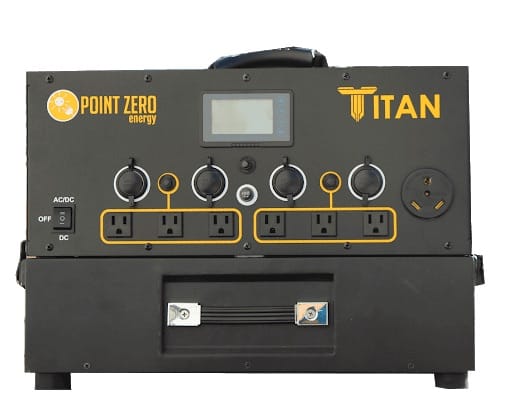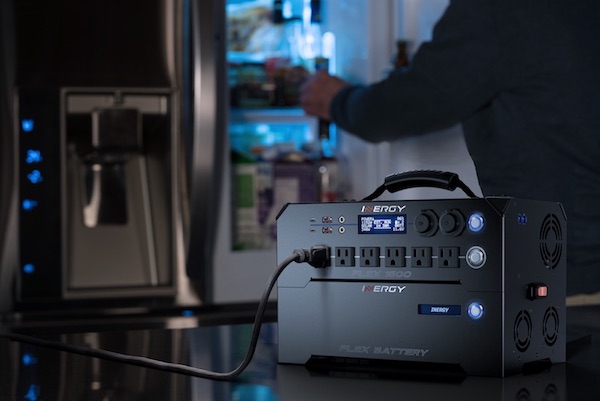In this article, I have compiled three of the best solar generators that will power full-size refrigerators flawlessly. I will be going in-depth on each solar generator listed and how long it can power your fridge using four common household refrigerators.
Here’s what you’ll learn:
- How to size up your solar generator in relation to your fridge model.
- A breakdown of power consumption in refrigerators using a traditional household fridge example.
- A quick view of the three power stations I’ll be covering.
- In-depth analysis of my #1 solar generator for fridges (along with an example scenario).
- My second solar generator on the list has the edge in terms of software/pairing capabilities.
- Last but not least is my third power station on the list – it’s versatility is what sets it apart.
What Size Solar Generator Do You Need to Run a Refrigerator?
A solar generator with at least a 2,000Wh (2 kWh) battery will run a full-size refrigerator for one day. To run the fridge for several days on end, you will need to have a solar input of at least 400W to completely recharge the battery during the day.
However, you may need to adjust your solar panel input depending on the size of your refrigerator.
“Domestic fridge power consumption is typically between 100 and 250 watts. Over a full day, a fridge records between 1 to 2 kilowatt-hours (kWh) of total energy usage…”
Ryan McCarthy of Reduction Revolution
Overall, the next question you may have is “What else can I power with a solar generator other than a fridge?”
To answer that question, you will first need to calculate the power consumption of the other devices/appliances you intend to run and compare that to the specifications of your solar generator.
To ensure you get enough power to run the items you’re looking to power, it’s best to get a battery (or batteries) that are bigger than you think you’ll need. This will ensure that you get the energy required to run your appliances with ease.
The next specification to review is the solar input. You need a high solar input in order to recharge the generator fast enough for it to run during the night and into the next day.
With these calculations, the intended outcome is for you to run your fridge for days while also supplying power to other essential electronics/appliances you may need while off the grid.
Power Consumption in Refrigerators
To be sure of whether you should power up your refrigerator with a solar generator, you must check the ratings on your fridge’s nameplate or in the manual listed online for your specific model.
The usual power rating given for refrigerators is in kWh per year.
For example, I’m going to use the 26 ft3 3-Door French Door Smart Refrigerator made by LG Electronics.
The listed power consumption is 708 kWh/year. In order to use a solar generator with this fridge, we need to know:
- How much power is used per day in watt-hours (Wh)
- How much power the fridge is consuming at any given time
After this information is calculated, we can then match it with a solar generator that can perform according to the refrigerator’s stats.
How much power is used per day in watt-hours (Wh)
From the LG fridge example, take its 708 kWh and divide it by 365 to get the daily kWh power consumption, which is about 1.94 kWh.
Next, we’re going to multiply by 1,000 because a kWh (kilowatt-hour) is 1,000Wh (watt-hours). This comes out to 1,940Wh.
How much power the fridge is consuming at any given time
A modern refrigerator typically only uses power for about eight hours per day. If you think your fridge runs for longer or if you have an older fridge, I recommend getting a power meter that will show you the details of your fridge’s power consumption.
All you do is plug it into the refrigerator’s power cord and then plug it into the wall. However, for the LG example, I have, let’s say it uses its power for eight hours per day.
Full-size refrigerators use anywhere from 100-250 watts of power when they are on and active.
We want to find out where in this spectrum the LG fridge runs in terms of watts (W).
Taking the daily power usage in watt-hours (1,940Wh), divide this by the hours when the fridge is powered on through one day of work. We said that in one day it will only be on for eight hours total.
1,940 watt-hours used per day / 8 hours of operation = 242.5 watts
The LG refrigerator uses about 243 watts of power when it is on.
This calculation allows us to know how big of a battery we need for the solar generator (in watt-hours) and how much power we need it to give to the fridge when it turns on (in watts).
Best Solar Generators for Your Fridge – Quick View
| Solar Generator for Refrigerator | Wattage | Battery Capacity | Price Range | Where to Buy |
|---|---|---|---|---|
| 1. Point Zero Energy Titan | 3,000W | 2,000Wh | $2,995-3,395 | Shop Solar Kits |
| 2. EcoFlow Delta Pro | 3,600W | 3,600Wh | $3,299-3,599 | Shop Solar Kits |
| 3. Inergy Flex 1500 AC | 1,500W | 1,069Wh | $1,250-1,500 | Inergy website Use code at checkout for 10% off: CXVBV5656 |
The best solar generator for a refrigerator is the Point Zero Energy Titan. It has a 3,000W continuous AC inverter, high solar input (2,000W max), and expandable 2,000Wh batteries to keep your fridge running for days. However, you may want one with different features depending on your needs.
If you’re interested in using DIY solar generators to power your fridge, I have an article breaking down the components necessary to do so here: Can You Run a Refrigerator on Solar Power? Advantages & Breakdown.
1. Point Zero Energy Titan
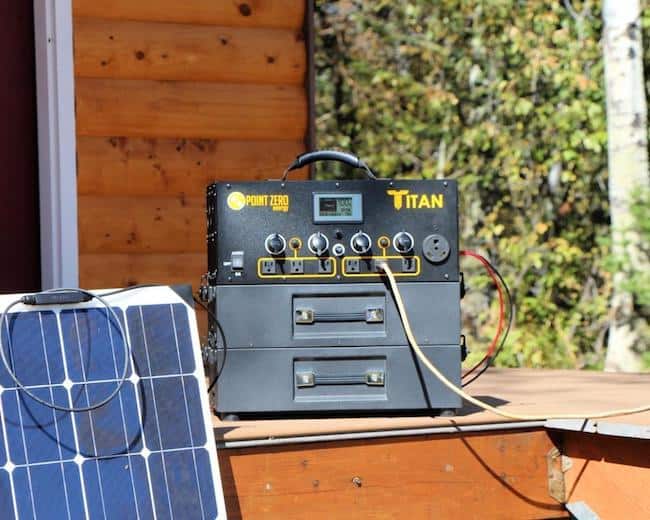
In the table below, I give the estimated hours of runtime for the Titan with four common full-size home refrigerators.
| Refrigerator Model | Samsung 28.2 cu. ft. French Door Refrigerator | LG 26 cu. ft. 3-Door French Door Smart Refrigerator | GE 27.7 cu. ft. French Door Refrigerator (Energy Star) | Whirlpool 28 cu. ft. Side-by-Side Refrigerator |
|---|---|---|---|---|
| Energy Consumption (kWh/Year) | 645 | 708 | 725 | 747 |
| Daily Energy Consumption (Wh) | 1,767 | 1,940 | 1,986 | 2,047 |
| Standard Titan (2,000Wh) – Usable Hours Without Solar | 24 hours | 22 hours | 21.5 hours | 21 hours |
| Titan x2 Batteries (4,000Wh) – Usable Hours Without Solar | 48 hours | 44 hours | 43 hours | 42 hours |
| Standard Titan – Usable Hours With Max Solar Input (1,000W) | Unlimited | Unlimited | Unlimited | Unlimited |
| Titan x2 Batteries – Usable Hours With Max Solar Input (2,000W) | Unlimited | Unlimited | Unlimited | Unlimited |
The Titan solar generator remains one of the most efficient solar generators on the market, and they are perfect for refrigerators.
Leading the market in their technology, the makers of the Titan, Point Zero Energy, put two MPPT charge controllers in the Titan, allowing you to charge with up to 1,000W of solar panels with one battery and 2,000W with two or more batteries attached.
This stat makes it one of a handful of the fastest-charging solar generators on the market today.
The Titan comes with removable and expandable lithium-ion batteries that allow you to add as many batteries as you need for your home/cabin with ease.
Each battery is 2,000Wh which is rated for 2,000 charge cycles to 80% battery capacity.
To better understand these numbers, if I were to use the Titan (with one battery) every day and use it completely (from 100%-0% then charge it up again), it would last about 5.5 years before its battery capacity reduces to 80% of its original 2,000Wh.
Scenario – 3 Days Off-Grid With the Titan Solar Generator (4,000Wh)
For a more detailed understanding of the Titan’s capabilities, I’ve put together an example scenario where a family has lost access to grid power for three days and only has access to the Titan solar generator.
I tried making this mock scenario as realistic as possible and included other electronics that may be used in an event of a power outage (including a full-size fridge).
I created a separate page for this experiment/scenario that you can find here. At the bottom is a big table with all of the data and the results.
Titan Solar Generator – Main Specifications
Battery Specs
- Battery Type: Lithium-ion NMC
- Battery Capacity: 2,000Wh
- Battery Cycle Life: 2,000 cycles to 80% capacity
Output Ports
- AC Inverter (w/ one battery): 1,500W continuous, 3,000W surge
- AC Inverter (w/ two or more batteries): 3,000W continuous, 6,000W surge
- (1) RV 30A outlet
- (6) 120V AC outputs
- (4) USB adapters (8 ports total): Two with two smart USB-A, two with one smart USB-A, and one USB-C
- (4) DC car cigarette lighter outputs (regulated at 13.8V)
Charging/Input Ports
- (2) PV (solar) inputs, 35-145V/30A per port (up to 2,000W total)
- Solar Input (w/ one battery): 1,000W max
- Solar Input (w/ two or more batteries): 2,000W max
- (2) AC charging inputs (600W each, 1,200W total)
- (1) Car cigarette lighter DC input
- (1) Battery expansion input (for third-party external batteries)
Other
- Inverter Power Consumption: 5-20W
- Weight (Module + One Battery): 67 lbs
- Dimensions (w/ one battery): 18.5 x 12 x 12 inches
Find my full review of the Titan here where I go more in-depth on its specifications and features as well as what it comes with: Titan Solar Generator Review – The Best Large Solar Generator?
The Titan is available on shopsolarkits.com. They also offer Titan kits with solar panels and/or additional batteries.
My ideal choice for powering my fridge and other appliances/electronics is the Titan solar generator kit with two batteries and 1,500W of solar panels (affiliate link).
2. EcoFlow Delta Pro
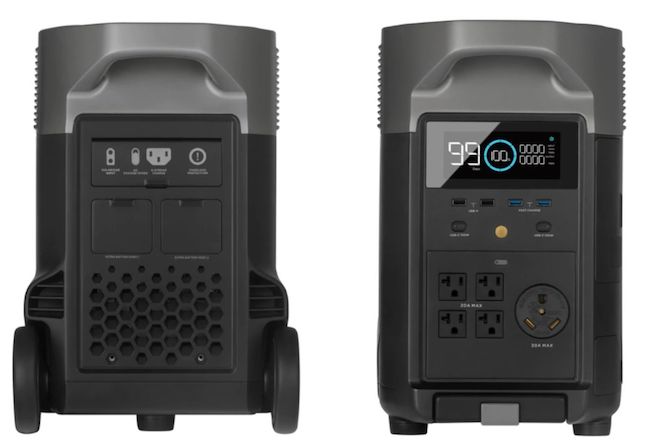
The EcoFlow Delta Pro is a high-capacity solar generator equipped with a 3,600Wh LiFePO4 battery.
Specifically for powering home refrigerators, check out the table below for running hours with and without solar recharging.
| Refrigerator Model | Samsung 28.2 cu. ft. French Door Refrigerator | LG 26 cu. ft. 3-Door French Door Smart Refrigerator | GE 27.7 cu. ft. French Door Refrigerator (Energy Star) | Whirlpool 28 cu. ft. Side-by-Side Refrigerator |
|---|---|---|---|---|
| Energy Consumption (kWh/Year) | 645 | 708 | 725 | 747 |
| Daily Energy Consumption (Wh) | 1,767 | 1,940 | 1,986 | 2,047 |
| EcoFlow Delta Pro (3,600Wh) – Usable Hours Without Solar | 44 hours | 40 hours | 39 hours | 38 hours |
| EcoFlow Delta Pro – Usable Hours With Max Solar Input (1,600W) | Unlimited | Unlimited | Unlimited | Unlimited |
With 12 output ports, the Delta Pro can power other electronics and appliances in addition to your fridge. You can also extend its battery capacity from 3.6kWh to a maximum of 25kWh with multiple Smart Extra Batteries, which are specifically designed for the Delta Pro.
One of the major benefits of this system is its included application called the EcoFlow app. This application comes in handy when using it to power your fridge and other appliances as you can monitor the charge/battery status as well as turn on/off ports from your phone.
This option is great for people who would like to use a solar generator with a refrigerator while on and off the grid. You can use the EcoFlow app’s Direct Connection Mode feature while off the grid to monitor your Delta Pro.
When on the grid, you can connect your smartphone to the generator via WiFi to have it power your fridge whenever you need it to.
EcoFlow Delta Pro – Main Specifications
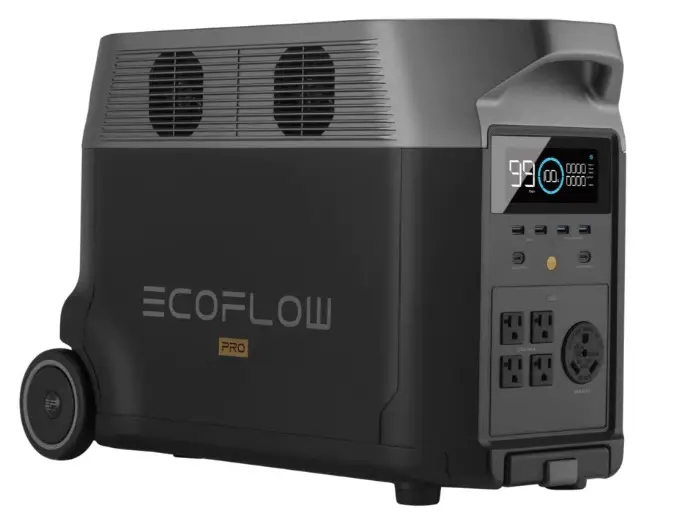
Battery Specs
- Battery Type: LiFePO4 (LFP)
- Battery Capacity: 3,600Wh
- Battery Cycle Life: 3,500 cycles to 80% capacity
Output Ports
- AC Inverter: 3,600W continuous, 7,200W surge
- (1) RV 30A AC outlet
- (4) 120V AC outputs
- (2) USB-A ports (12W max per port)
- (2) USB-C ports (100W max per port)
- (2) DC5521 outputs (38W max per port)
- (1) 12V car port (126W max)
Charging/Input Ports
- Solar charging input: 11-150V/15A (1,600W max)
- Solar charge time @ max input (1,600W): 2.8-5.6 hrs
- AC charging input: 120V/15A (1,800W max); 240V/12.5A (3,000W max)
- AC charge times: 2.7 hrs @ 1,800W; 1.8 hrs @ 3,000W
- EV charging (using EV charger): 1.7 hrs @ 3,400W
- Car charging input: 12V or 24V battery @ 8A
Other
- Weight: 99 lbs
- Dimensions: 25 x 11.2 x 16.4 in
There are additional port options next to the main output section on the Delta Pro. I have a 60-second clip below showing you the details.
If you’re considering this option, I recommend using Shop Solar Kits because they have the Delta Pro at $100 less than EcoFlow’s website and they also include a remote monitor. You can compare the options below to see if any deals/changes occurred.
3. Inergy Flex 1500 AC
The Inergy Flex is a modular solar generator that has a very similar design to the Titan.
The Flex’s AC ports offer 1,500 watts of continuous power (3,000W surge) while its DC ports are all regulated at 13.8V.
Each Flex battery is 1,069Wh. On the right-hand side of this solar generator, you can insert up to 400W of solar input. With an optional MPPT charge controller from Inergy, you can increase the solar input to 1,200W maximum.
You can also make use of a wall socket or a car charging port to charge up this generator.
Here is the layout of the Flex AC when powering the following home refrigerators:
| Refrigerator Model | Samsung 28.2 cu. ft. French Door Refrigerator | LG 26 cu. ft. 3-Door French Door Smart Refrigerator | GE 27.7 cu. ft. French Door Refrigerator (Energy Star) | Whirlpool 28 cu. ft. Side-by-Side Refrigerator |
|---|---|---|---|---|
| Energy Consumption (kWh/Year) | 645 | 708 | 725 | 747 |
| Daily Energy Consumption (Wh) | 1,767 | 1,940 | 1,986 | 2,047 |
| Standard Flex AC (1,069Wh) – Usable Hours Without Solar | 13 hours | 12 hours | 11.5 hours | 11 hours |
| Flex AC x2 Batteries (2,138Wh) – Usable Hours Without Solar | 26 hours | 24 hours | 23 hours | 22 hours |
| Standard Flex AC – Usable Hours With Max Solar Input (400W) | Unlimited | Unlimited | 11.5 hours (generator will shut down in morning because not enough battery for fridge) | 11 hours (generator will shut down in morning because not enough battery for fridge) |
| Flex AC x2 Batteries – Usable Hours With Max Solar Input (400W) | Unlimited | Unlimited | Unlimited | Unlimited |
| Flex AC x2 Batteries + MPPT Supercharger – Usable Hours With Max Solar Input (1,200W) | Unlimited | Unlimited | Unlimited | Unlimited |
The table above mentions the MPPT Supercharger that gives a total of 1,200W of solar input. This is an add-on to the Flex generator that gives you three times the standard charging wattage from solar panels.
Getting this add-on is my recommendation for you if you intend to get a second or third battery pack because it will ensure that you will be able to fully recharge the Flex before nightfall.
This will prepare the generator to power your fridge throughout the entire night.
Inergy Flex AC – Main Specifications
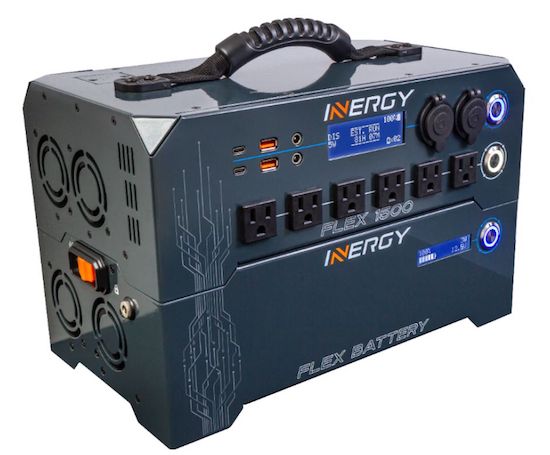
Battery Specs
- Battery Type: Lithium-ion
- Battery Capacity: 1,069Wh
- Battery Cycle Life: 400-2,000 cycles to 80% capacity*
*Inergy has not given more accurate information on this wide range of charge cycles (400-2,000). They claim that if you use the system correctly and take proper care of the battery, it can last for up to 2,000 cycles.
Output Ports
- AC Inverter: 1,500W continuous, 3,000W surge
- (6) 110-120V AC outlets
- (2) 60W USB-C PD ports
- (2) USB-A ports with QC 2.0
- (2) 5.5mm x 2.5mm DC outputs for LEDs & accessories
- (2) 10A cigarette lighter ports w/ 13.8V regulated DC output
Charging/Input Ports
- (1) EC8 input port
- Solar Charging Time (w/ max input of 400W): 3.5-4 hours
- Wall Charger (100W): 10.5-hour recharge time
- Maximum charge rate per flex battery (w/ optional Flex MPPT Supercharger): 1 hour
Other
- 13.8V Regulated DC Power: Increases run time and stability for 12V devices
- Weight (w/ one battery): 30 lbs
- Dimensions: 14 x 8 x 8.9 inches
I have a comparison article that puts the Inergy Flex up against the Titan solar generator.
This article will give you a better idea of their similarities and differences to find the best model for your needs. You can find this comparison post here: Yeti 3000 vs. Titan – Two of the Most Powerful Solar Generators.
Continue Reading:

